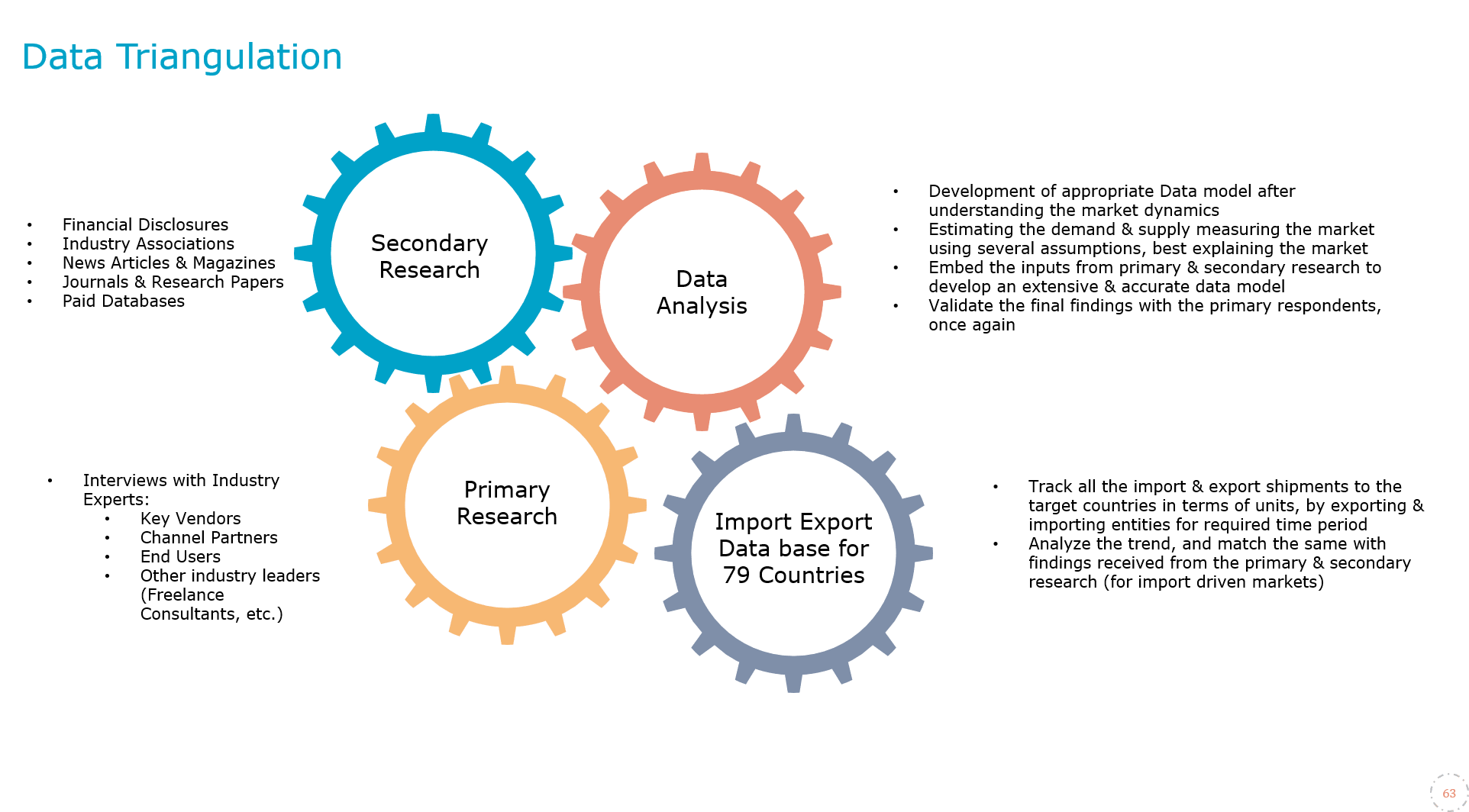
Global Aircraft Central Processing Unit (CPU) Market Research Report: Forecast (2022-27)
By Type (Single Core, Dual Core, Multi-Core), By Aircraft Type (Commercial Aircraft, Passenger Aircrafts, Cargo Jets, Helicopters), Military Aircraft (Fighter Jets, Cargo Jets, Hel...icopters, Drones & Others), By Region (North America, South America, Europe, Middle East & Africa, Asia-Pacific), By Company (Pythium Technology Co., Ltd., NXP Semiconductors N.V., L3harris Technologies, Inc., ARM Ltd., Intel Corporation, Qualcomm Inc., Advanced Micro Devices, Inc.) Read more
- Aerospace & Defense
- Mar 2022
- Pages 221
- Report Format: PDF, Excel, PPT
Market Definition
Aircraft Central Processing Unit (CPU) refers to the silicon chips located on the computer’s motherboard, used in the aircraft avionics, responsible for processing all the information being collected & displaying it to the mission display computers. The integration of newer fourth- & fifth-generation aircraft and the increasing focus of the large militaries to acquire the respective combat jets in the air force has surged the demand for aircraft manufacturing, which, in turn, has increased the demand for aircraft CPUs.
Market Insights
The Global Aircraft Central Processing Unit (CPU) Market is projected to grow at a CAGR of around 4.46% during the forecast period, i.e., 2022-27. The increasing military expenditure & focus on air mobility are the major factors contributing to the market's growth, which will lead to an increase in CPU demand for commercial & military aircraft. Moreover, several countries, including the US, India, China, the UK, France, Japan, etc., have increased their aviation expenditures exponentially to enhance their air combat capabilities amid escalating geopolitical tensions.
| Report Coverage | Details |
|---|---|
| Study Period | Historical Data: 2017-20 |
| Base Year: 2021 | |
| Forecast Period: 2022-27 | |
| CAGR(2022-27) | 4.46% |
| Regions Covered | North America: USA, Canada, Mexico |
| Europe: Germany, UK, Russia, France | |
| Asia-Pacific: China, India, Japan, South Korea, Australia and Others | |
| South America: Brazil, Argentina | |
| Middle East & Africa: Israel, Saudi Arabia, South Africa | |
| Key Companies Profiled |
Pythium Technology Co., Ltd., NXP Semiconductors N.V., L3harris Technologies, Inc., ARM Ltd., Intel Corporation, Qualcomm Inc., Advanced Micro Devices, Inc. |
| Unit Denominations | USD Million/Billion |
- In 2018, Ireland imported 248 large planes from non-EU countries representing 53% of total EU military aircraft imports, with Poland & the UK comprising 7% & 34% of the total EU military aircraft imports, respectively. Additionally, France exported 349 large planes to non-EU countries in 2018.
- In 2017, governments of the UK & Qatar signed a contract worth USD7.7 billion to purchase 24 Eurofighter aircraft.
Additionally, the up-gradation of the existing legacy fleet of aircraft to enhance the air combat readiness to match the existing capability of the 4th & above generation of aircraft is also one of the prominent reasons for the rising growth of aircraft CPUs in the coming years. Moreover, the upcoming plans of different countries to replace the old air fleet with newer aircraft would be crucial for the enhancement in the production of military jets and the consequent growth in the demand for CPUs to be integrated into the newer aircraft.
- In 2021, the Government of India approved the request for 56 C295 transport aircraft from Airbus, of which 40 military aircraft would be manufactured & assembled by the Tata Advanced Systems Ltd. in India.
Key Trends in the Market
- Rising Population & High Traffic is Propelling the Demand for Air Taxis
With the growing global population, traffic congestion is on the rise in urban areas. In turn, this has increased the demand for technically advanced transportation systems such as air taxis, manufactured by various aircraft manufacturers, like Lilium, Airbus, Kitty Hawk, etc. Hence, to handle the vast amount of data collected by air taxis, the manufacturing companies will require highly efficient CPUs with better memory & power usage, and improved software & hardware. Furthermore, to reduce the pollution caused by air taxis, various companies are collaborating extensively with governments of several countries across the globe for developing electrical air taxis & their infrastructures.
- In 2021, Air Taxi India launched India's first air taxi service from Chandigarh Airport. The demand for air taxis is expected to increase in India in the coming years due to its vast population and the objective of providing faster travel & connectivity.
- In the year 2020, Volocopter, a German-based aircraft manufacturer, conducted the first crewed test flight of an Electronic Vertical Takeoff and Landing (eVTOL) air taxi in Seoul, South Korea.
Besides, the increasing demand for convenient, faster, and more comfortable transportation is propelling the demand for air taxis, which, in turn, would accelerate the need for higher-performing CPUs to control the technically advanced electric air taxis.
-Market.jpg)
Impact of Covid-19 on the Global Market
Due to the COVID-19 pandemic, the aircraft CPU market witnessed a sudden decline, causing challenges & economic problems for the industry. The system integration of aircraft components was severely affected by the first wave in 2020 across Europe & America. Eventually, the manufacturing pipeline of the leading manufacturers such as Boeing, Airbus, Lockheed Martin, etc., faced a delay in execution. Additionally, the instant decline in demand for passenger aircraft due to lowered passenger travel, led by the government's travel restrictions, resulted in the reduction of new aircraft in 2020. According to the International Air Transport Association (IATA), the overall number of flights reduced by 80% as of April 2020, compared to 2019.
However, in 2021-2022, the market started to recover, owing to global semi-conductor chip shortages caused due to disruption of semi-conductor manufacturing activities. Despite these challenges, the market is expected to recover completely from supply-side challenges by late 2022, thereby positively impacting the growth of the processor market in the coming years.
Market Segmentation
By Type:
- Single-core
- Dual-core
- Multi-core
Among the three, single-core processor held the prominent market share in the Global Aircraft CPU Market in 2021. Due to technological limitations for multi-core processor development, these processors have been extensively used in older generation aircraft. The rigorous certification process for using multi-core processors in commercial aviation is another prominent factor affecting the demand for single & dual-core processors for aircraft CPUs.
Additionally, several existing passenger aircraft like the Boeing 737 Max, among many others, still use Intel 80286, a single-core processor that created a growth opportunity for the demand for single-core processors in North America, Europe & Asia-Pacific markets during 2017-2020. Furthermore, high replacement costs of aircraft would also hinder the penetration of multicore processors, which, in turn, would drive the demand for single & dual-core aircraft CPUs globally during 2022-27.
By Aircraft Type:
- Commercial Aircrafts
- Passenger aircraft
- Cargo jets
- Helicopters
- Military Aircraft
- Fighter jets
Of them all, the military aircraft type is expected to lead the Global Aircraft CPU Market during 2022-27. The emerging need of several countries worldwide to strengthen their military capabilities due to the rising geopolitical tensions & trade rivalries among countries such as India, China, the USA, Russia, etc., have encouraged the need for advanced military aircraft production. This, in turn, has contributed significantly to the increasing demand for aircraft processors such as the intel 80186, intel 80836, intel i7 gen, etc., across North America, Europe, & Asia-Pacific on account of the presence of aircraft manufacturing in these regions.
Furthermore, increasing partnerships & strategic agreements for the production & distribution of advanced military aircraft in Europe, Asia-Pacific, and the US have also escalated the demand for aircraft CPUs worldwide.
Regional Landscape
- North America
- South America
- Europe
- The Middle East & Africa
- Asia-Pacific
Geographically, North America grabbed the largest market share in the Global Aircraft CPU Market in 2021, with the high demand for military aircraft coupled with the existence of many leading commercial & military aviation manufacturers, such as Boeing, Bombardier, Lockheed Martin, Northrop Grumman, etc. Furthermore, the US is home to various CPU providers such as Qualcomm, Intel, L3 Harris, etc., which eases the procurement of processors for aircraft manufacturers. In addition, the technological developments in the military aircraft segment in the region are projected to strongly contribute towards creating the demand for CPU in the forecast period. For instance, the US is focused on developing 6th-generation fighter jets to gain superiority in the air combat field.
Moreover, the demand for aircraft central processing units (CPUs) in Europe increased during 2017-2019, driven by the growing focus of European governments to strengthen their military bases, burgeoning air travelers, owing to lower airfares & rising purchasing power of European residents. Additionally, the growing inclination of the European Union towards improving the warfare capabilities to eliminate the threat of enemy air strikes in military warfare & naval aircraft are the key factors that contributed to the rising demand for military aircraft in the region.
Recent Developments by Leading Companies
- In 2022, Augusta Westland announced that it had received around 70 orders for its AW189 SAR variant, including orders from Bristow Helicopters. These helicopters will be manufactured & assembled in Yeovil, Somerset, the UK.
- In the year 2022, Augusta Westland announced the delivery of six AW 169 helicopters to the UK Specialist Aviation Services (SAS).
- In 2021, the UAE signed a strategic deal with the French government for 80 French-made Rafael fighter jets. The production is still undergoing and scheduled to be completed by 2024.
Market Dynamics:
Key Drivers: High Demand for Military Aircrafts Across the Globe
Global geopolitical uncertainties, and the growing need to keep a robust air power by the countries such as China, India, etc., have boosted the demand for military aircrafts such as fighter jets, helicopters, airborne early warning & control system aircraft, cargo planes, etc. Moreover, extensive investments have been made by leading countries such as China, the US, the nations of NATO (North Atlantic Treaty Organization), India, Japan, Taiwan, etc., for the expansion of military jets. Among them, the US, India, Russia, and China have been the four largest air forces, contributing to the increase in aircraft manufacturing and overhaul & maintenance of old aircraft.
Possible Restraints: Sanctions on Key Defense Exporters & Importers to Restrict the Market of Fire Control Systems
The growing geopolitical tensions & imposed sanctions on many of the defense exporters such as Russia, Turkey, etc., have restricted the ease of availability of fire control systems to many of the recipient countries. Moreover, defense equipment such as air defense systems, aircraft, naval ships, missiles, etc., requires both replenishment in terms of the availability of the spare parts to maintain & operate the systems on optimum efficiency.
However, with the sanctions against many countries, easy replenishment & availability of hardware have been limited, resulting in a decline in possible demand for fire control systems. Besides, some countries, such as Saudi Arabia, Iran, Argentina, etc., face sanctions from many of the major defense manufacturing countries, resulting in a market access restriction for manufacturers of fire control systems.
Growth Opportunities: Rising Mandates for the Use of Modular Open System Approach to Boost the Demand for Aircraft CPU
Aircraft manufacturers such as Boeing, Airbus, Lockheed Martin, etc., often deploy CPUs in their aircraft with different processing power typically sourced from specific vendors. In turn, aircraft manufacturers become increasingly dependent on vendors, limiting technological advancements. Furthermore, at times of economic crisis, trade restrictions, and geopolitical tensions with the CPU sourcing country, result in severe supply chain disruptions causing an economic decline. Further, to eliminate the cost of an economic crisis, the aircraft manufacturers & government of the US are increasingly adopting various initiatives such as the use of the Modular Open System Approach (MOSA) to eradicate supply chain dependencies.
Moreover, the use of common standards in all aircraft enables seamless inter-platform communications, portability, and scalability. As a result, this reduces the number of systems required to field new technology & eliminates clutter caused by unnecessary cabling & accessories. Additionally, vendor independence increases the sources of supply & helps to eliminate vendor lock-in & increases vendor competition. Consequently, this enables aircraft manufacturers to choose parts from a variety of suppliers, thus reducing maintenance & workforce training costs.
Key Questions Answered in the Market Research Report:
- What are the overall statistics or estimates (Overview, Market Size- By Value, Forecast Numbers, Segmentation, Market shares) of the Global Aircraft Central Processing Unit (CPU) Market?
- What are the region-wise market size, growth drivers, and challenges?
- What are the key innovations, opportunities, current & future trends, and regulations in the Global Aircraft Central Processing Unit (CPU) Market?
- Who are the key competitors, their key strengths & weaknesses, and how do they perform in the Global Aircraft Central Processing Unit (CPU) Market based on the competitive benchmarking matrix?
- What are the key results derived from surveys conducted during the Global Aircraft Central Processing Unit (CPU) Market study?
Frequently Asked Questions
- Introduction
- Product Definition
- Research Process
- Assumptions
- Market Segmentation
- Preface
- Executive Summary
- Impact of COVID-19 on Global Aircraft Central Processing Unit (CPU) Market
- Impact of Artificial Intelligence (AI) on the Aircraft Central Processing Unit (CPU) Market
- Global Aircraft Central Processing Unit (CPU) Market Government Regulations and Policies
- Global Aircraft Central Processing Unit (CPU) Market Trends & Insights
- Global Aircraft Central Processing Unit (CPU) Market Dynamics
- Growth Drivers
- Challenges
- Impact Analysis
- Global Aircraft Central Processing Unit (CPU) Market Hotspot & Opportunities
- Global Aircraft Central Processing Unit (CPU) Market Outlook, 2017-2027F
- Market Size & Analysis
- Market Revenues
- Market Share & Analysis
- By Type
- Single Core
- Dual Core
- Multi-Core
- By Aircraft Type
- Commercial Aircraft
- Passenger Aircrafts
- Cargo Jets
- Helicopters
- Military Aircraft
- Fighter Jets
- Cargo Jets
- Helicopters
- Drones & Others
- Commercial Aircraft
- By Region
- North America
- South America
- Europe
- Middle East & Africa
- Asia-Pacific
- By Competitors
- Competition Characteristics
- Market Share & Analysis
- By Type
- Market Size & Analysis
- North America Aircraft Central Processing Unit (CPU) Market Outlook, 2017-2027F
- Market Size & Analysis
- Market Revenues
- Market Share & Analysis
- By Type
- By Aircraft Type
- By Country
- The US
- Canada
- Mexico
- The US Aircraft Central Processing Unit (CPU) Market Outlook, 2017-2027F
- Market Size & Analysis
- Market Revenues
- Market Share & Analysis
- By Type
- By Aircraft Type
- Market Size & Analysis
- Canada Aircraft Central Processing Unit (CPU) Market Outlook, 2017-2027F
- Market Size & Analysis
- Market Revenues
- Market Share & Analysis
- By Type
- By Aircraft Type
- Market Size & Analysis
- Mexico Aircraft Central Processing Unit (CPU) Market Outlook, 2017-2027F
- Market Size & Analysis
- Market Revenues
- Market Share & Analysis
- By Type
- By Aircraft Type
- Market Size & Analysis
- Market Size & Analysis
- South America Aircraft Central Processing Unit (CPU) Market Outlook, 2017-2027F
- Market Size & Analysis
- Market Revenues
- Market Share & Analysis
- By Type
- By Aircraft Type
- By Country
- Brazil
- Argentina
- Others
- Brazil Aircraft Central Processing Unit (CPU) Market Outlook, 2017-2027F
- Market Size & Analysis
- Market Revenues
- Market Share & Analysis
- By Type
- By Aircraft Type
- Market Size & Analysis
- Argentina Aircraft Central Processing Unit (CPU) Market Outlook, 2017-2027F
- Market Size & Analysis
- Market Revenues
- Market Share & Analysis
- By Type
- By Aircraft Type
- Market Size & Analysis
- Market Size & Analysis
- Europe Aircraft Central Processing Unit (CPU) Market Outlook, 2017-2027F
- Market Size & Analysis
- Market Revenues
- Market Share & Analysis
- By Type
- By Aircraft Type
- By Country
- Germany
- The UK
- France
- Russia
- Others
- Germany Aircraft Central Processing Unit (CPU) Market Outlook, 2017-2027F
- Market Size & Analysis
- Market Revenues
- Market Share & Analysis
- By Type
- By Aircraft Type
- Market Size & Analysis
- The UK Aircraft Central Processing Unit (CPU) Market Outlook, 2017-2027F
- Market Size & Analysis
- Market Revenues
- Market Share & Analysis
- By Type
- By Aircraft Type
- Market Size & Analysis
- France Aircraft Central Processing Unit (CPU) Market Outlook, 2017-2027F
- Market Size & Analysis
- Market Revenues
- Market Share & Analysis
- By Type
- By Aircraft Type
- Market Size & Analysis
- Russia Aircraft Central Processing Unit (CPU) Market Outlook, 2017-2027F
- Market Size & Analysis
- Market Revenues
- Market Share & Analysis
- By Type
- By Aircraft Type
- Market Size & Analysis
- Market Size & Analysis
- Middle East & Africa Aircraft Central Processing Unit (CPU) Market Outlook, 2017-2027F
- Market Size & Analysis
- Market Revenues
- Market Share & Analysis
- By Type
- By Aircraft Type
- By Country
- Israel
- Saudi Arabia
- South Africa
- Others
- Israel Aircraft Central Processing Unit (CPU) Market Outlook, 2017-2027F
- Market Size & Analysis
- Market Revenues
- Market Share & Analysis
- By Type
- By Aircraft Type
- Market Size & Analysis
- Saudi Arabia Aircraft Central Processing Unit (CPU) Market Outlook, 2017-2027F
- Market Size & Analysis
- Market Revenues
- Market Share & Analysis
- By Type
- By Aircraft Type
- Market Size & Analysis
- South Africa Aircraft Central Processing Unit (CPU) Market Outlook, 2017-2027F
- Market Size & Analysis
- Market Revenues
- Market Share & Analysis
- By Type
- By Aircraft Type
- Market Size & Analysis
- Market Size & Analysis
- Asia-Pacific Aircraft Central Processing Unit (CPU) Market Outlook, 2017-2027F
- Market Size & Analysis
- Market Revenues
- Market Share & Analysis
- By Type
- By Aircraft Type
- By Country
- China
- India
- Japan
- South Korea
- Others
- China Aircraft Central Processing Unit (CPU) Market Outlook, 2017-2027F
- Market Size & Analysis
- Market Revenues
- Market Share & Analysis
- By Type
- By Aircraft Type
- Market Size & Analysis
- India Aircraft Central Processing Unit (CPU) Market Outlook, 2017-2027F
- Market Size & Analysis
- Market Revenues
- Market Share & Analysis
- By Type
- By Aircraft Type
- Market Size & Analysis
- Japan Aircraft Central Processing Unit (CPU) Market Outlook, 2017-2027F
- Market Size & Analysis
- Market Revenues
- Market Share & Analysis
- By Type
- By Aircraft Type
- Market Size & Analysis
- South Korea Aircraft Central Processing Unit (CPU) Market Outlook, 2017-2027F
- Market Size & Analysis
- Market Revenues
- Market Share & Analysis
- By Type
- By Aircraft Type
- Market Size & Analysis
- Market Size & Analysis
- Global Aircraft Central Processing Unit (CPU) Market Key Strategic Imperatives for Success & Growth
- Competition Outlook (Whichever Applicable)
- Competition Matrix
- Target Markets
- Research & Development
- Collaborations & Strategic Alliances
- Key Business Expansion Initiatives
- Business Restructuring- Mergers, Acquisitions, JVs
- Strategic Initiatives
- Company Profiles (Business Description, Product Segments, Business Segments, Financials, Strategic Alliances/ Partnerships, Future Plans)
- Pythium Technology Co., Ltd.
- NXP Semiconductors N.V.
- L3harris Technologies, Inc.
- ARM Ltd.
- Intel Corporation
- Qualcomm Inc.
- Advanced Micro Devices, Inc.
- Competition Matrix
- Disclaimer
MarkNtel Advisors follows a robust and iterative research methodology designed to ensure maximum accuracy and minimize deviation in market estimates and forecasts. Our approach combines both bottom-up and top-down techniques to effectively segment and quantify various aspects of the market. A consistent feature across all our research reports is data triangulation, which examines the market from three distinct perspectives to validate findings. Key components of our research process include:
1. Scope & Research Design At the outset, MarkNtel Advisors define the research objectives and formulate pertinent questions. This phase involves determining the type of research—qualitative or quantitative—and designing a methodology that outlines data collection methods, target demographics, and analytical tools. They also establish timelines and budgets to ensure the research aligns with client goals.
2. Sample Selection and Data Collection In this stage, the firm identifies the target audience and determines the appropriate sample size to ensure representativeness. They employ various sampling methods, such as random or stratified sampling, based on the research objectives. Data collection is carried out using tools like surveys, interviews, and observations, ensuring the gathered data is reliable and relevant.
3. Data Analysis and Validation Once data is collected, MarkNtel Advisors undertake a rigorous analysis process. This includes cleaning the data to remove inconsistencies, employing statistical software for quantitative analysis, and thematic analysis for qualitative data. Validation steps are taken to ensure the accuracy and reliability of the findings, minimizing biases and errors.

4. Data Forecast and FinalizationThe final phase involves forecasting future market trends based on the analyzed data. MarkNtel Advisors utilize predictive modeling and time series analysis to anticipate market behaviors. The insights are then compiled into comprehensive reports, featuring visual aids like charts and graphs, and include strategic recommendations to inform client decision-making









